Buying into the dream
Cessna Skycatcher after a year--one club's experience
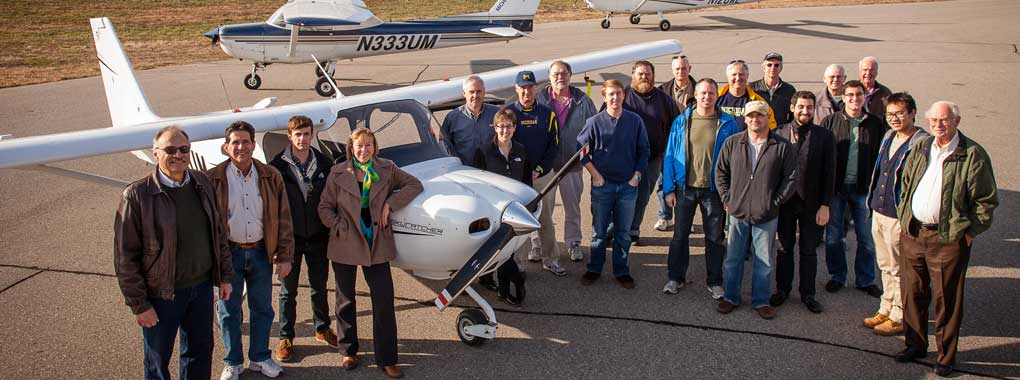
Photography by Mike Fizer
In the fall of 2009, with the number of new Light Sport aircraft on the market or “coming soon” burgeoning, a significant portion of the membership of the Ann Arbor-based Michigan Flyers expressed interest in acquiring an LSA for its club. The reasons varied, but included the desire to get in on the latest in aeronautical developments as well as attract new members who wanted to take advantage of the Sport Pilot rules, allowing flight with only a driver’s license as a medical certificate.
As the year ended, the choices had been pared down to a Cessna 162 Skycatcher. The club was a Cessna Pilot Center, had operated Cessnas since its inception in 1969, and would be able to take advantage of Cessna support as the new model went through its inevitable teething pains.
Cost was, of course, an issue. It would mean financing the airplane and pricing it on the rental line in a fashion that would cover payments on a six-figure loan. That lead to serious questions as to whether members would actually fly the airplane at the required rental price. The club’s Cessna 152s were solid moneymakers. Long paid for, they had been completely refurbished in the 1990s to keep them attractive, and were maintained in excellent condition. With fixed costs including hangar, engine reserve, and insurance, they were on the line for $78 per hour.
According to the club’s president, Harry Crespy, it was anticipated that the Skycatcher could be rented for $100 per hour wet if it flew about 380 hours a year; something that seemed reasonable, as the 152s averaged 700 hours per year.
With a university town membership that included scientists, engineers, airline pilots, and sophisticated e-business people, it’s no surprise that the club kept detailed operating cost records on all of its aircraft, seasonally adjusted for use—so club treasurer, Bruce Williams, knew to the penny what each cost to run. The club would be subjecting the Skycatcher to the same financial scrutiny.
The next step was financing. The Flyers turned to a practice it had used over the years; some of its members pooled their funds and loaned the needed money to the club at an interest rate higher than they were getting in the market but lower than the club could obtain through commercial lenders. The club was considered a good risk—in its more than 40 years of existence it had never defaulted on a loan.
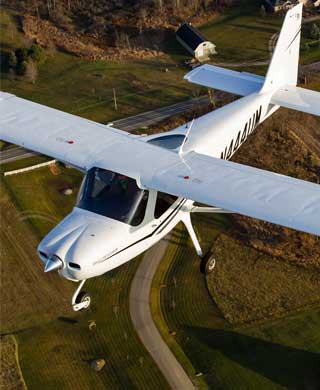
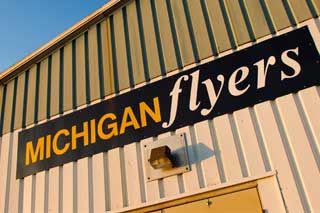
The order was placed. The club’s Skycatcher, soon to become N444UM, was picked up in June 2011 by club instructor Kathryn Robine and student Andy Fowler (who has since become a private pilot and is working on his instrument rating). Robine, a former Learjet freight dog and airline pilot who obtained several of her ratings with the Michigan Flyers and had experience flying legacy LSAs, was the perfect choice to be the first club instructor in the new type. Robine and Fowler spent significant time with Cessna personnel getting the lowdown on the Skycatcher.
They were warned of the position and color of the pitot tube (small diameter, gray, right at eye level; blends in with the color of ramps and hangar walls) and to make certain the cabin doors were latched, as at least one had already come open in flight and wrapped itself around the wing strut. They were advised (and soon learned) that the airplane would perform like a 152 on steroids and that the 22-knot maximum wind recommendation should probably be treated as a limitation.
Time would prove the warnings to be spot on. Fowler and Robine flew the airplane back to Ann Arbor, marveling at a cruise speed that was closer to the club’s 172s than to the 152s, while delaying a portion of the trip because surface winds climbed above 25 knots.
By the end of the following June the club’s Skycatcher had flown fewer than 200 hours. The Flyers learned much in that year, while keeping meticulous cost records.
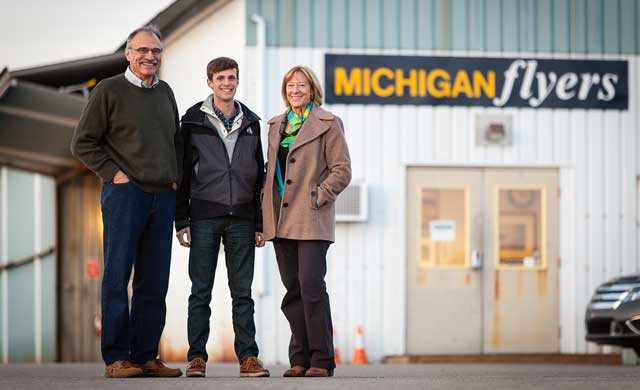
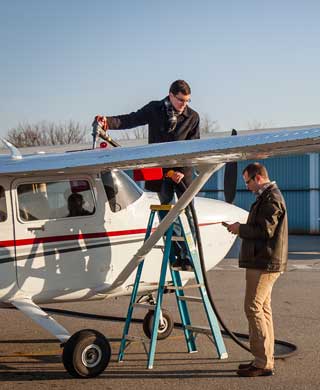
It’s fun
After the first year of operation, club members overwhelmingly described the airplane with one word, “fun.” Its short takeoff and strong climb performance were commented on by everyone; they liked the light pitch and roll forces (yaw is heavier) and that it does not roll off in a stall, even if the ball is not perfectly centered.
Robine’s take on the airplane after giving dual instruction in it for more than a year was to point out that the Skycatcher is simply and essentially a fun airplane to fly. On a hot summer day, with an instructor and student in one of the 152s, they have to deal with a long takeoff roll and a slow climb to altitude; the 162 is off the ground in a hurry and climbing at about 800 fpm. The side effect Robine noticed was that completing a given lesson in the Skycatcher takes about 10 minutes less than in a 152 because the Skycatcher “gets up and out” to the practice area faster.
The Garmin G300 panel received strong reviews; it is more intuitive and simpler to use than the G1000 in one of the club’s 172s. The fast start-up time was considered a plus, especially as it is used during the preflight to very rapidly determine the weight and balance of the airplane and make a decision as to how much fuel can be carried.
Weight is a constant source of discussion. Because of the limited useful load (462 pounds), the club established special rules for the 162. All of the other club airplanes are topped off after at least 1.4 hours of flight and at the end of the day. The Skycatcher is not to be fueled after a flight but rather prior, by the person who is about to use it.
The Garmin provides a way to quickly determine the amount of fuel that may be added, and the plastic-tube fuel gauges in the wing roots are simple and reasonably accurate. The club also changed its rule requiring members to land with an hour of fuel aboard to 30 minutes for the Skycatcher.
Weight played a big role in the options that were selected when the airplane was ordered. Once in use, the club swapped the metal prop for a composite one, a weight savings of 12 pounds —“two more gallons of fuel,” as Robine described it.
The large vertical tail surface affects ground handling in wind and includes a dorsal fin that can strike the runway if one tries a full-stall landing. The Flyers added a skid to the underside of the dorsal fin to help protect it.
The Skycatcher was successful in attracting new members interested in acquiring a Sport Pilot rating. As expected, almost all of the prospects were older men who were uncertain whether they could pass an FAA medical exam. The unintended consequence was that many of those men also were packing more than a few extra pounds, which meant some of them could not take advantage of the airplane.
When the first student got ready for his checkride, a problem arose: There were no approved examiners in the Detroit area svelte enough to fly with the applicant and carry more than about an hour of fuel in the airplane. Robine contacted a slender designated examiner she knew and convinced her to go through the FAA hoops necessary to be approved to administer checkrides in the 162.
Club members overwhelmingly describe the Skycatcher as fun to fly, with a cruise speed close to the club’s Cessna 172s.
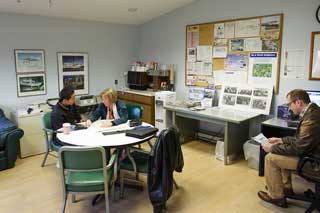
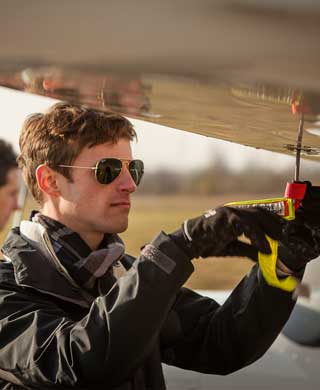
Taking care
With the light airframe there was serious concern about the ability of the airplane to stand up to a rental and student environment. The club aggressively taught its members about care in handling the airplane on the ground, yet it expected reports of dented or damaged structure. Happily, there were none. The members use the tow bar when pushing the airplane back; no one pushes down on the rear fuselage or horizontal stabilizer to maneuver the airplane, something that has damaged 152s. The extra care may mean that damage has been avoided; however, for an airplane to have made it through a year without major dings in a rental environment is indicative that it’s not all that fragile.
The warned-of pitot tube and door latch issues proved true. Despite a club rule that a brightly colored cover be on the pitot tube at all times other than when the airplane is moving, there have been injuries. So far no lost eyeballs; just some gashed heads. Club members wonder why Cessna didn’t paint the pitot a bright color. Also, despite great care in assuring the doors were latched, one did come open at about 400 feet after takeoff. It wrapped itself around the wing strut, as advertised. Instructor Joe Moraboto took over the airplane and flew it back to the runway, maintaining between 70 and 80 KIAS. He said the airplane was easily controlled. And, after some discussion, Cessna paid for the repairs. Cessna also developed a secondary door latch, which the club installed and has worked flawlessly.
There were unexpected quirks to work out. Checking the oil involves a slightly different push-and-turn procedure to replace the dipstick, so there have been oily messes after a flight when the dipstick was not properly secured. The combination of hot brakes and their location near where one steps when debarking have meant some burned ankles post flight.
As the airplane’s susceptibility to turbulence became known, flights were scheduled only up until about noon or in the evenings. That cut into usage, as did the two-week downtime to replace the door. Further, windy days meant students in the Skycatcher were grounded when they could have flown the 152s. The wisdom of a conservative wind policy was verified when a student in another flight school’s LSA (not a Skycatcher) lost control on takeoff on a gusty day and wrecked the airplane.
The initial $100 per hour price proved to be too low; it was increased to $104 almost immediately. At that price usage was poor, about 15 hours per month compared to more than 55 for each 152. In June 2012 the price was lowered to $78 per hour to match the 152s. Usage shot up to nearly 70 hours in the next month, confirming the prediction that demand was very price elastic.
While the members love the fun handling and performance as well as the intuitive glass cockpit, they have not been very willing to pay an extra $26 an hour for the joy. When the 152s and 162 were priced the same, the Skycatcher got the nod, except when weight or wind was an issue.
One problem has been that although most maintenance has been covered by warranty—and it hasn’t needed a great deal—it still takes time for someone to get warranty claims processed and paid.Plus, the Skycatcher seems to eat tires and brakes. Surprisingly, maintenance costs for the 162 have worked out to be the same as the 152s—$14 per hour.
The club hasn’t decided whether to continue the reduced price on the Skycatcher; it means using the other club airplanes to subsidize it. The members are starting to look at the future and the decision whether to put more money into the 152s to again upgrade the interiors and avionics, which will cause the hourly price to increase somewhat, or buy another Skycatcher (or do both). They like the performance, handling, glass, and the fact that the 162 has proven more robust than expected in service. However, the financial realities of buying and operating a new 162 versus a refurbished 152 are going to make for some interesting discussions among the club membership in the next few months.
Rick Durden holds an ATP and CFII, is a regular contributor to AOPA Pilot, and was a member of the Michigan Flyers in the 1970s.
A college flying club owned by the students
The University of Michigan Flyers, as the club was originally called, got its start in the 1910s, although the precise date has been lost to history, as have details such as the identity of the members and the airplanes they flew. It is known that club members competed in the first-ever college flying competition organized by the National Intercollegiate Flying Association (NIFA) in 1929. The Depression and World War II took their toll on the club and somewhere in the 1940s it faded away.
As the country went through its turmoil in the late 1960s and colleges, particularly the University of Michigan, were centers of vocal—and occasionally violent—discontent with the social status quo, some Michigan undergraduate and graduate students got together to do something about their personal discontent with the absence of a university flying club. But Dave Fradin, Ron Levy, Richard Hoesli, David Gell, Patricia Cleary, Loren Henke, John Dobson, and Philip Stern soon found out that the school would not sponsor or support a flying club.
The reason given (whether true or not) was that, despite having one of the first aeronautical engineering departments in the world, the University of Michigan (U-M) had entered into an agreement with its historic football rival, The Ohio State University (OSU), regarding aviation and space.
As Ohio, dating from the Wright brothers, had been the cradle of powered flight in the United States, OSU would concentrate its efforts on aviation and generally stay out of the space side of aerospace. The U-M would emphasize the space portion of the equation despite its aero-engineering school having produced the likes of Kelly Johnson, creator of Lockheed’s famed Skunk Works.
The schools would thus not duplicate efforts or compete for scarce resources, and the U-M would not do anything to support a flying club. OSU is rightfully famous for its aviation activities while U-M built a pipeline into the space program, providing some eight astronauts—notably the all-Michigan crews of Gemini 4 and Apollo 15.
Undeterred by the university’s stance, the original group of students formed a corporation, the University of Michigan Flyers, Inc., and started a flying club with Ms. Cleary as its first instructor. Over the years the college-student-owned and operated flying club acquired a fleet of airplanes that numbered as high as 14, including, at various times, an Apache, a ski-equipped Luscombe, a Decathlon in which both inside and outside aerobatic instruction was given, traveling machines such as a Beech Debonair and Cherokee Arrow, as well as two- and four-place Cessnas.
For some time membership was limited to U-M students, alumni, faculty, and staff. As everything in aviation slowed down in the early portion of this century, that requirement was dropped, although the majority of members do have some connection to the university.
Historically, it was a point of pride at NIFA flying competitions that the Michigan Flyers was the only team that didn’t have a “faculty advisor” (although the team would sometimes come up with some name when the NIFA couldn’t understand the concept that the team was its own adult supervision). In reality, when faculty members joined the club, they found that their flight instructors were students at U-M
The challenge of undergraduates and grad students not only dealing with rigorous studies at one of the top schools in the nation while owning and running a flying club may have been a positive influence in their future success. At least two grad students obtained their ATP rating through the club while working on their degrees; former members are now involved in the space program, several are airline or corporate pilots, some went into military aviation (where one became a U.S. Navy Blue Angel), a few became aviation lawyers—and several have gone into management and ownership of aviation-related businesses, including the largest U.S. provider of aviation fuel. Not a bad result from the efforts of some ‘60s-era “college kids.” —RD


